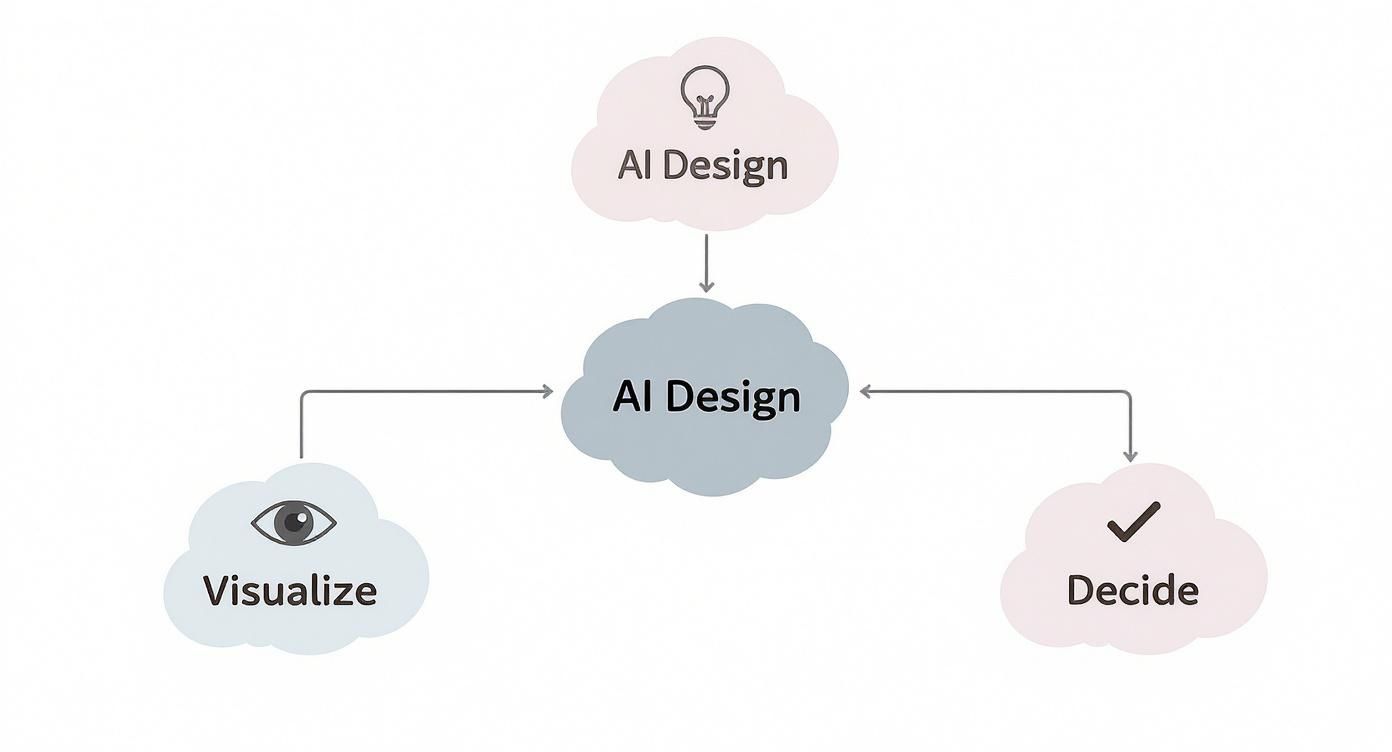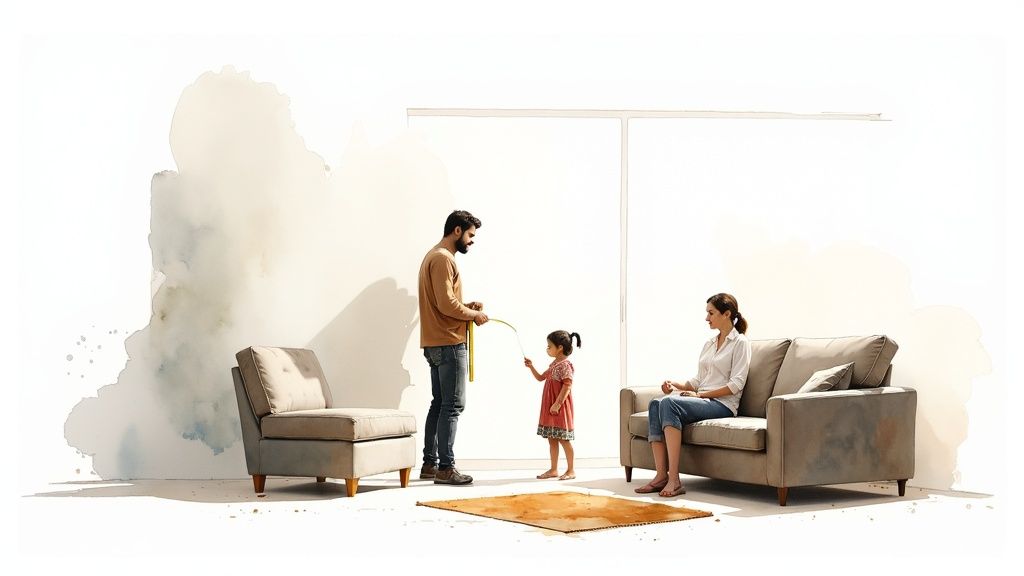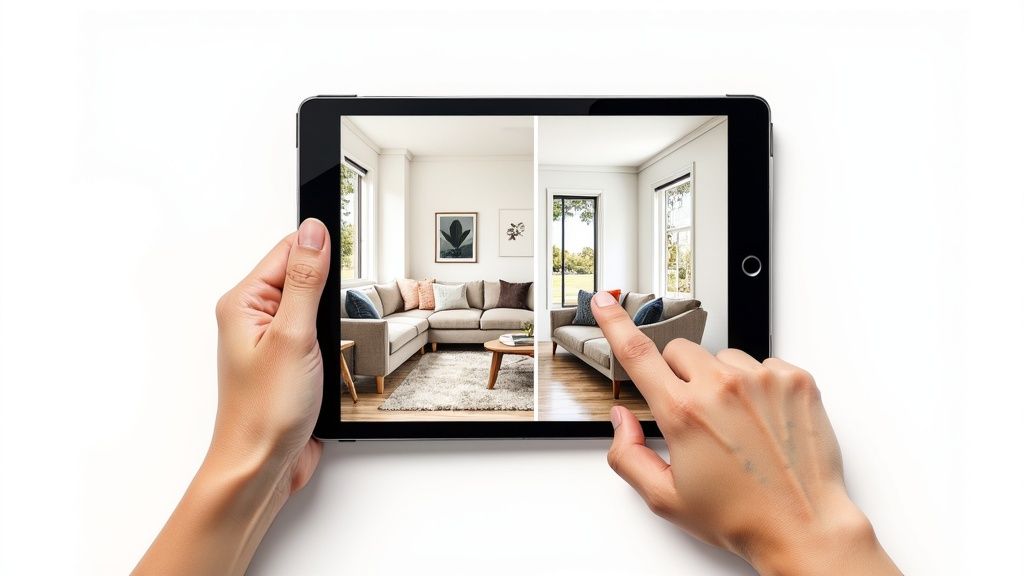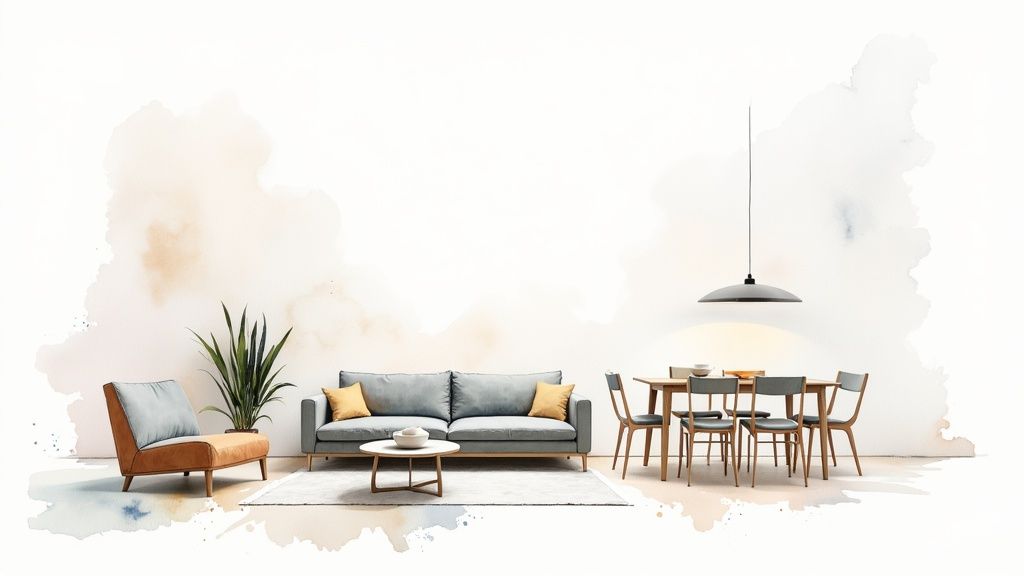Your Guide to Home Design AI

Think of home design AI as your personal creative assistant, one that can take a fuzzy idea in your head and turn it into a stunning, lifelike picture in seconds. It’s essentially a digital “try before you buy” for everything from your home’s layout to its decor, cutting out the guesswork and helping you sidestep expensive design regrets.
The New Way to Imagine Your Home
We’ve all been there—staring at an empty or outdated room, completely stuck on where to even begin. The journey from a vague concept to a finished space can feel overwhelming, filled with endless paint swatches, furniture catalogs, and clunky mood boards. This is exactly where home design AI changes the game, turning what was once a stressful chore into a genuinely fun and creative adventure.
Instead of just trying to picture how a new sofa might look, you can actually see it in your room. Rather than wondering if a coastal vibe works with your living room’s lighting, you can generate a dozen different takes on the theme in just a few minutes. This kind of tool gives homeowners and renters the confidence to make smart, informed choices about their space.
Visualize Before You Commit
At its heart, the magic of these tools is all about visualization. They give you a creative safety net, letting you experiment freely with bold colors, funky furniture arrangements, or a complete style overhaul without any real-world risk. Being able to preview these changes has some serious practical upsides:
- Avoid Costly Mistakes: See how that pricey velvet couch or trendy paint color actually looks before you pull out your credit card.
- Save Valuable Time: Why spend hours researching and creating manual mockups when you can generate countless design options instantly?
- Unlock Hidden Potential: AI can suggest layouts and ideas you might never have thought of, all perfectly suited to your room’s specific size and shape.
This isn’t some futuristic concept; it’s a real, accessible tool you can use right now to improve your home. The market is exploding for a reason. Valued at USD 1.541 billion in 2024, the AI home design market is on track to hit USD 3.43 billion by 2031, all thanks to tools that make the design process so much more efficient.
By turning simple text descriptions into detailed images, these platforms tear down the wall between your imagination and a real design plan. It’s less about needing to be a design expert and more about knowing what you love.
If you want to see just how quickly AI can bring ideas to life, it’s worth checking out some of the best free AI image generators available today. This technology puts you in the driver’s seat, making beautiful, personalized home design more accessible than ever before.
How AI Learns to Think Like a Designer
Ever wondered how a piece of software can grasp something as subjective as a “cozy” vibe or a “modern” aesthetic? The technology driving home design AI isn’t magic. It’s a fascinating learning process that mirrors how a human designer builds their expertise over time.
Think about an aspiring interior decorator poring over millions of images from design magazines, Pinterest boards, and architectural photos for years. An AI starts in much the same way. It’s fed a massive dataset of images, kickstarting a process powered by a technology called machine learning. During this phase, the AI isn’t just passively looking at pictures; it’s actively learning to identify the fundamental building blocks of a room.
A related field, computer vision, trains the AI to recognize patterns and objects. It learns to tell the difference between walls and windows, a sofa and a coffee table, or a pendant light and a floor lamp. This digital “eye” gets incredibly good at analyzing spatial relationships, color palettes, textures, and layouts across every image it sees.
From Understanding to Creating
Once the AI has a firm handle on what makes up a room, it shifts from simply analyzing to actually creating. This is where generative models enter the picture. These powerful algorithms don’t just recognize existing designs—they can dream up entirely new ones.
So, when you upload a photo of your living room and ask for a “minimalist Scandinavian” look, the AI isn’t just cutting and pasting elements. It’s applying the design principles it has learned directly to your space. It knows “minimalist Scandinavian” usually means neutral colors, natural materials like light wood, clean lines, and a distinct lack of clutter. The AI then synthesizes these rules to creatively re-imagine your room, generating a fresh visual concept that matches your request.
For a closer look at the tools that bring this to life, check out our guide on AI interior design software.
The AI essentially acts as a translator between your words and a visual result. It turns abstract human desires—like wanting a “warm and inviting” feel—into tangible design elements like soft lighting, plush fabrics, and a specific color palette.
This infographic simplifies the AI design workflow into three core stages: visualizing, experimenting, and deciding.

This flow shows how AI empowers you to move smoothly from an initial idea to exploring different options and, finally, to making a confident design choice.
The Power of Your Prompt
Your text prompt is the final, and most important, piece of the puzzle. The AI uses your words to steer its creative output. The more specific you are, the more accurate and personalized the results will be.
For example, look at the difference here:
- Initial Prompt: “Make my living room modern.”
- Refined Prompt: “Redesign my living room in a mid-century modern style, featuring a walnut media console, a teal armchair, and brass light fixtures.”
That second prompt gives the AI so much more to work with, leading to a design that’s far closer to what you’re imagining. This ability for AI to generate 3D models with AI from text and images is what makes these tools so powerful. By blending its vast visual library with your specific instructions, the AI becomes a true collaborative partner, ready to produce stunning, relevant design concepts in just a few seconds.
The Real-World Wins of Designing with AI

Sure, getting an instant room makeover from a home design AI is impressive. But once the initial “wow” fades, you’re left with the real value: these tools are built to solve the tangible, often frustrating problems that come with decorating a home. They act as a creative co-pilot, giving you the confidence to make decisions that actually fit your taste, your space, and your budget.
This isn’t just a fun gimmick; it’s a fundamental shift in how we approach interior design. The market is exploding, valued at USD 1.47 billion in 2024 and expected to jump to USD 6.96 billion by 2032. Why? Because homeowners and designers alike are finding real, cost-effective solutions in these tools. You can dig into the numbers in this AI interior design market research.
Save Money by Dodging Costly Mistakes
One of the biggest fears in any design project is making an expensive mistake. We’ve all been there—hovering over a “buy” button for a new sofa or staring at a bold paint swatch, paralyzed by the thought, “What if this looks terrible?”
AI takes the financial guesswork completely out of the equation.
Imagine you’re picturing a deep, moody emerald green accent wall. Instead of buying paint, testing patches, and hoping for the best, you just upload a photo of your room. In seconds, you see exactly how it will look. If it’s not right, you’ve lost nothing. The same goes for that big-ticket sofa or a new dining set—you can see if it fits the room and your vision before spending a dime.
Go from Idea to Finished Design in Minutes, Not Months
The old way of designing could be a real slog. It meant spending hours, days, or even weeks hunting for inspiration, piecing together mood boards, and constantly second-guessing every choice. AI collapses that timeline from months to minutes.
Instead of slowly gathering ideas one by one, you can generate dozens of complete, polished concepts in an instant. This lets you explore way more creative options and land on a final decision faster than ever before.
Think about a family struggling with an awkwardly shaped living room. Trying to sketch layouts by hand is tedious and often doesn’t lead to the best solution. With AI, they can generate multiple arrangements that make the most of the space, complete with furniture and decor ideas, finding a beautiful and functional layout almost immediately.
Get a Look That’s Truly Your Own
Your home should feel like you, but translating your unique personality into a cohesive design can be tough. AI is brilliant at creating personalized spaces that break free from cookie-cutter trends. It looks at your text prompts and the photo of your room to suggest styles and ideas you might never have thought of on your own.
For example, maybe you’re a renter who loves the “dark academia” vibe but feel stuck on how to pull it off without making permanent changes. An AI tool can show you exactly how to get that look with specific types of furniture, lighting, and art. It gives you a clear, actionable plan that works for a temporary space.
Comparing Traditional vs AI-Powered Home Design
Looking at the old and new methods side-by-side really brings the differences into focus. It’s not just about speed; it’s about making the entire process more accessible, creative, and less risky.
| Aspect | Traditional Design Process | AI-Powered Home Design |
|---|---|---|
| Time Investment | Weeks or months of research and planning. | Minutes to generate multiple design concepts. |
| Financial Risk | High risk of costly purchase mistakes. | Virtually no risk; visualize before you buy. |
| Idea Generation | Limited by personal experience and research. | Access to a vast range of styles and layouts. |
| Customization | Requires significant effort to personalize. | Creates highly personalized results from simple prompts. |
Ultimately, AI puts powerful design capabilities into your hands, letting you experiment freely and confidently create a space you’ll love.
Your First AI Redesign: A Simple 4-Step Walkthrough
All the theory in the world doesn’t compare to seeing your own living room transform right before your eyes. That’s where the magic of home design AI really clicks. So, let’s jump in and walk through the process together. In just four quick steps, you’ll see how easy it is to take a simple photo and turn it into a handful of stunning new design concepts.

This screenshot shows exactly what it looks like in action—you upload your room and start playing with different styles to instantly see what’s possible.
Step 1: Snap a Picture of Your Space
Every great AI redesign starts with a good photo. Think of your picture as the canvas you’re giving the AI to paint on. Your goal is simple: give it a clear, well-lit shot of the room you want to reimagine.
A few quick tips to get the best results:
- Go with Natural Light: Whenever possible, open the curtains and snap your picture during the day. This helps avoid the weird shadows and yellow-ish tints from artificial lights. An overcast day is often perfect for soft, even lighting.
- Clear the Decks: You don’t have to scrub the floors, but tidying up stray items helps the AI see the room’s actual shape and features.
- Find the Right Angle: Stand in one corner of the room and aim your camera towards the opposite corner. This classic real estate trick captures more of the space and gives the AI a better feel for its dimensions.
A quality photo is the foundation. It gives the AI the raw data it needs to produce something that looks both realistic and inspiring.
Step 2: Pick a Core Design Style
With your photo uploaded, it’s time for the fun part: giving the AI some creative direction. Most tools will present you with a menu of design styles. This is your playground to test-drive different vibes without having to move a single piece of furniture.
You’ll usually find a lineup of popular styles, such as:
- Modern: Known for its clean lines, simple colors, and materials like metal and glass.
- Industrial: All about that warehouse look—think exposed brick, unfinished wood, and metal accents.
- Coastal: Light, breezy, and relaxed. It’s full of soft colors and natural textures that make you feel like you’re at the beach.
- Bohemian: An eclectic, free-spirited style packed with vibrant colors, patterns, and a mix-and-match feel.
Choosing a style is your primary instruction for the AI. It tells the algorithm what kind of furniture, color palettes, and overall mood to aim for. Don’t be shy about picking something wild—you might just discover a look you never realized you loved. If you’re wondering which tool has the best options, our guide on choosing an AI app for interior design can help you narrow it down.
Step 3: Write a Short, Descriptive Prompt
This is where you get to whisper in the AI’s ear and add your personal touch. A text prompt is just a simple instruction telling the AI what you want to see. The more specific you are, the closer the result will be to what you’re picturing in your head.
It’s like talking to a real designer. You wouldn’t just say, “Make it look good.” You’d give them details to work with.
A great prompt is what takes an AI-generated image from generic to yours. It’s the bridge between a broad style and a personalized design that truly fits your life.
Here’s how to craft a powerful prompt:
- Start with the Style: Begin with the basics, like “A cozy Minimalist living room.”
- Call Out Key Pieces: Mention specific furniture you want, such as “with a large, L-shaped gray sectional and a round oak coffee table.”
- Guide the Colors & Materials: Get specific with your palette. Try adding “…using warm wood tones, cream fabrics, and black metal light fixtures.”
- Describe the Vibe: How should the room feel? End with something like “The room should feel bright and airy with lots of natural light.”
Step 4: Generate and Compare Your Designs
Once you have your photo, style, and prompt locked in, you’re ready to hit the “generate” button. In just a few moments, the AI will process everything and spit out several unique design concepts.
Now you can sit back and compare the results. You’ll notice the AI often gives you slightly different interpretations of your prompt—one might have a different furniture arrangement, while another might experiment with a bolder color accent. Pick your favorites, save them, and use them as your inspiration board for the real thing.
Creative Uses for Home Design AI
Redesigning a living room is a great start, but it barely scratches the surface of what home design AI can do. Think of this technology as a visual problem-solver, a tool that helps professionals and homeowners alike tackle all sorts of creative challenges, both inside and out. Its uses are surprisingly broad and incredibly practical.

From staging an empty apartment to planning a dream patio, AI offers a fast and affordable way to see an idea come to life. Let’s jump into some of the most creative ways people are using it.
Virtual Staging for Real Estate
An empty house might seem like a blank canvas, but for most buyers, it’s just an empty, uninspiring box. This is where virtual staging completely changes the game for real estate agents. Forget spending thousands on renting furniture and hiring stagers; with AI, an agent can digitally furnish a property in just a few minutes.
All it takes is uploading photos of the vacant rooms. The AI then generates photorealistic images showing the space fully decorated in different styles. Suddenly, buyers aren’t just looking at walls—they’re picturing their own lives unfolding there. It’s a simple step that helps homes sell faster and often for a better price, making AI a must-have in today’s market.
Planning Commercial and Business Spaces
The magic of design AI isn’t just for homes. Small business owners are finding it invaluable for mapping out their commercial spaces before sinking money into furniture or renovations. It’s the perfect way to turn a business plan into a physical reality.
Just imagine the possibilities:
- A New Coffee Shop: The owner can play with different table arrangements and counter placements to create a cozy vibe that still fits plenty of customers.
- A Boutique Office: A startup can visualize an open-plan layout, testing where to put desks, collaboration pods, and breakout areas to keep the team happy and productive.
- A Retail Store: A shop owner can map out product displays and traffic flow to build an intuitive and inviting shopping experience from day one.
Landscape and Outdoor Design
Why stop at the front door? Many AI tools can now tackle outdoor areas, from tiny apartment balconies to huge backyards. This lets you plan your dream garden, patio, or outdoor kitchen with the same point-and-click ease as a bedroom makeover.
You can upload a photo of your yard and ask the AI to show you what it would look like with a vegetable garden, a stone fire pit, or even a swimming pool. It’s perfect for visualizing planting schemes and furniture layouts, helping you turn a neglected patch of grass into a beautiful, functional extension of your home. Digging into these advanced AI applications for interior design and exterior projects shows you just how far this tech can go.
By 2033, the AI in interior design market is expected to hit roughly USD 7.299 billion. Back in 2023, space planning and design tools already made up 37% of that market. This explosive growth shows just how quickly the industry is embracing smarter, AI-driven solutions. You can dive deeper into these trends and learn more about the AI interior design market findings on market.us.
What’s Next for AI in Home Design
The tools we have today are really just scratching the surface. The technology powering home design AI is moving incredibly fast, and what’s coming next isn’t just about making designs quicker or more accurate. We’re talking about a future where the digital and physical worlds blend together almost seamlessly. The line between what you can imagine and what you can create is about to get very, very blurry.
Hyper-Realism and Augmented Reality
One of the most exciting developments on the horizon is the push toward hyper-realistic 3D rendering. Pretty soon, the designs an AI spits out will look so real they’ll be hard to tell apart from professional photographs. This makes visualizing a finished space easier than ever before.
This incredible realism will go hand-in-hand with much deeper augmented reality (AR) integration. Just imagine pointing your phone at your empty living room and seeing a virtual sofa, rug, and coffee table pop into existence, perfectly scaled to the room. You’ll be able to walk around these digital objects, see how the light from your window hits them, and swap out styles with a tap. This shifts AI from just a planning tool to a truly interactive, in-the-moment experience.
From Inspiration to Instant Purchase
The next logical step? Connecting the design directly to the shopping cart. Future AI platforms are poised to become smart shopping assistants, closing the gap between seeing a great idea and actually making it happen.
The AI won’t just design your dream room; it will also put together a shopping list of all the items that match the look and fit your space. It could even suggest alternatives at different price points, turning a pretty picture into a real, actionable plan.
This will create a smooth path from inspiration to execution, making it unbelievably simple for anyone to bring a professional-looking design to life. Instead of just admiring a concept, you’ll be able to instantly buy everything you need to build it.
A New Partner for Professional Designers
AI isn’t here to replace human creativity—far from it. It’s set to become an essential partner for professional interior designers. By handling the tedious grunt work like drafting initial floor plans, sourcing products, or creating mockups, AI will free up designers to focus on what they do best.
This means more time for big-picture thinking, understanding a client’s unique lifestyle, and adding those personal, nuanced touches that an algorithm just can’t replicate. The future of home design AI is a collaborative one, where technology and human expertise work together to make beautiful, personalized design more efficient and accessible for everyone.
Got Questions About AI in Home Design? We’ve Got Answers.
Jumping into new technology always brings up a few questions, and home design AI is no different. It’s totally normal to wonder about how accurate it is, whether it’s easy to use, and what its real-world limits are.
We’ve gathered some of the most common questions people ask to give you a clear picture of what to expect. Think of this as your quick-start guide to designing with confidence.
Just How Accurate Are the Designs from AI Tools?
This is probably the number one question, and the answer is all about perspective. It’s best to think of AI-generated designs as incredibly detailed inspiration, not as a set of architectural blueprints. They’re fantastic at giving you a visual guide for a style, a color scheme, or a potential furniture layout.
But here’s the thing: the exact scale and placement are still conceptual. The AI might tweak a room’s proportions slightly or suggest a sofa that looks amazing but, in reality, is a few inches too big.
The visuals from a home design AI are your creative starting point, not the final measurement. They show you what’s possible so you can implement it with real-world accuracy.
So, use the AI’s output as your roadmap. But before you buy a single piece of furniture or knock down a wall, always, always pull out the measuring tape.
Do I Need to Be a Designer to Use These Tools?
Not at all. In fact, that’s the whole point. These platforms were built for people who have great ideas but no formal design training. They essentially put a designer’s eye in your pocket, handling the tricky principles so you can focus on the fun part: exploring what you love.
You don’t need to know a thing about color theory or the rules of spatial balance. The AI has already digested millions of professionally designed spaces and applies those same principles for you. Your only job is to point it in the right direction by picking styles and describing what you’re after. It’s a creative partnership—the AI handles the technical stuff, leaving you free to play.
Can AI Actually Help Me Stay on Budget?
This is an area that’s getting better all the time. Right now, most AI tools are focused on getting the visuals right, not on crunching the numbers. Very few can link you directly to shoppable products with real-time prices.
But that’s changing fast, with more tools starting to suggest specific items you can actually buy. For now, the smartest way to use AI for budgeting is to treat the design as your shopping list. Once you have a look you love, you can use it as a visual guide to hunt for similar, budget-friendly pieces yourself. It helps you get the style you want without the surprise price tag.
Ready to stop wondering and start seeing what’s possible? RoomGenius makes it easy to visualize your home’s potential in seconds. Just upload a photo, pick a style, and watch our AI bring your ideas to life. Try it today at https://www.room-genius.com and create the space you’ve always dreamed of.